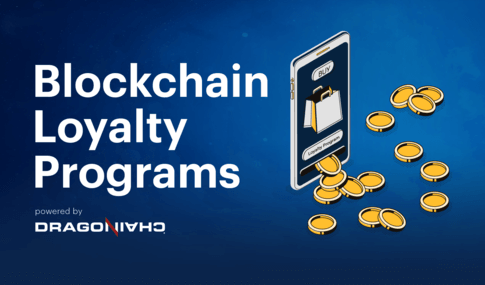How Dragonchain is using Blockchain-based Loyalty Programs and Rewards
One of the most commonly-seen problems in the blockchain and cryptocurrency space is the lack of follow-up or prolonged support for projects. In many cases, new blockchain projects drop off shortly after their ICO or after they have delivered the capabilities outlined in their whitepaper. This approach is not only detrimental to the community around a project, but also the long-term health of the project itself.
Dragonchain’s vision is one of continuous growth and an ongoing commitment to providing users the best in Blockchain as a Service. To this end, we created a unique loyalty program to reward users for engaging with the Dragonchain Platform and supporting its ecosystem. The longer someone is affiliated with Dragonchain by holding Dragon tokens, the more access and rewards they are able to attain. Though this may seem like a fairly intuitive model and functionality, it is the product of multiple technological innovations and firsts in the blockchain space.
TIME Defined
At the core of our blockchain loyalty program is the Dragon Days of Slumber Score, now known as TIME. This patented technology introduces the unprecedented ability to track and monetize actual time with blockchain, creating brand new value systems and blockchain capabilities. A user accumulates TIME for every day that a Dragon tokenized micro-license is held in a wallet, with each Dragon generating 1 TIME per day. TIME represents a unique instance of tokenized assets accruing their own value, independent of their price on the secondary market. The primary role of TIME is granting to access features on the Dragonchain Platform, but it is also designed to be compatible with functionalities such as discounts, priority access, and the forthcoming TIME Devotion system in the Dragonscale Competition.
Innovations in Consensus and Time Technology
TIME represents a breakthrough in both digital assets and loyalty rewards, since it is founded on a resource that can’t be replicated or fluctuate in value. The use of time as a metric for validation also introduces a new type of consensus mechanism, with distinct advantages over Proof of Stake and Proof of Work. Proof of Time, the consensus model made possible through TIME, is resistant to tampering and establishes a system that can’t be gamed by bad actors.
TIME also provides the unique capability to track the passage of time through the use of blockchain. By tracing an account’s change in TIME, one can create a record of timestamped events, resistant to doctoring thanks to blockchain’s immutable properties. This introduces the ability to prove, beyond doubt, if an event happened when someone says it did; people are no longer beholden to written or verbal accounts they can’t prove themselves.
Blockchain Loyalty Programs through TIME
In terms of blockchain loyalty programs, TIME goes beyond the passive reward systems commonly seen in other businesses by incentivizing positive behaviors in an ecosystem and limiting undesirable outcomes. The most direct example of this functionality can be seen in how the Dragonchain Platform uses TIME to eliminate speculation and drive adoption. By attaching time-based rewards to the Dragon tokenized micro-license, Dragonchain can limit trading based on expected financial gain and give back to users that use Dragons for their intended purpose. TIME helps bring in users that will add value to the Dragonchain ecosystem, attracting businesses and developers that use our Blockchain as a Service to build solutions.
Benefits of TIME for Users
From the user perspective, TIME also offers many advantages over other loyalty programs, blockchain-based or otherwise. One of the most appealing benefits of TIME as a loyalty system is that users don’t need to go out of their way to earn rewards. There is no need to make purchases or jump through hoops to earn TIME; it happens automatically as long as you have Dragons in a wallet, making for a consistent, effortless mechanism. TIME also separates the Dragon tokenized micro-license from other types of digital assets in that it allows Dragons to generate their own value, separate from secondary market prices. With this functionality in place, users are able to benefit from owning Dragons, regardless of the amount.
TIME for Security
A common concern in any network is sharing it with users you don’t know and having the possibility that a new user may come in with malicious intent. As a member of a network, you want the assurance that other entities, especially those with a lot of sway, are people you can trust. By the same token, you want structures in place that limit the disruptive potential of bad actors—TIME enables this type of security and grants you the ability to trust in your network. Since TIME serves as the determining factor for access to different features on the Dragonchain Platform, it is also the gating mechanism that keeps out potential threats.
TIME must be earned over time, meaning that an incoming user with malicious intent will have extremely limited access to the platform and therefore cannot pose a threat to other users. This gating system not only prevents potentially harmful activity, but also instills trust in the validation mechanism used on the Dragonchain Platform. With TIME requirements in place to spin up nodes, users can rest assured that the entities performing their validations are established members of the Dragonchain community with a real stake in its well-being.
The Future of TIME and Blockchain Loyalty Programs
Dragonchain has recently received a patent for blockchain loyalty systems, with TIME at the helm, and our plans for this technology are still only beginning. We will continue to integrate TIME into new products and functionalities, like the TIME Devotion system and Dragonscale Competition. With Dragonchain, enterprises can implement blockchain loyalty programs of their own. If you are interested in seeing how Dragonchain’s Blockchain as a Service can help you build your loyalty program solutions on blockchain, contact our sales team.
